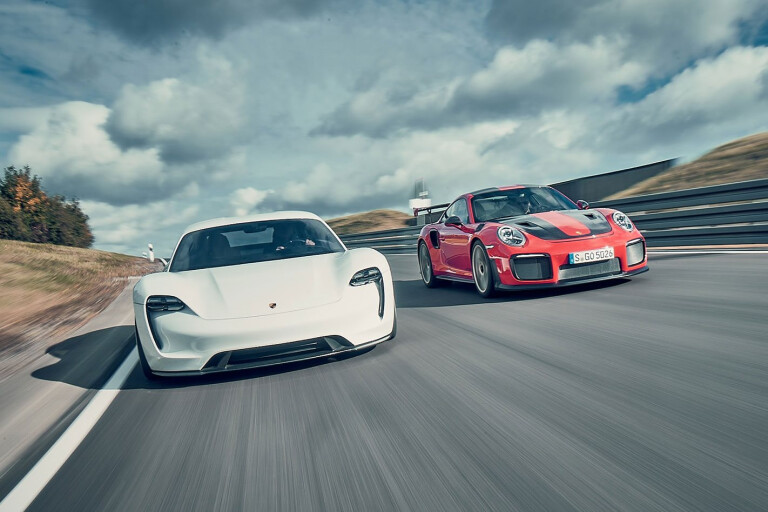
There will never be another day like this – 2018 911 GT2 RS meets 2020 Mission E.
While the pair are polar opposites in character and content, their DNA is fused by the desire to deliver maximum driving pleasure. In a way, it’s volt versus octane – or, more broadly, present versus future. Except, this time at least, there is no loser and this isn’t specifically a comparison. Electric drive may one day replace the iconic petrol-fed flat six, but for the time being, the two propulsion ideals are going to live side by side, as demonstrated by the plug-in hybrid. So let’s bask in the glory of what we have now while exploring the future.
Like its predecessors, the latest top-notch RS sold out long before the order books opened. The red and black beast we have here, model number 001, is the rarest of a rare breed. The 515kW/750Nm weapon is equipped with the desirable Weissach Pack, which cuts 30kg, yet adds a hefty price premium. However, when playing in this league, buyers want the ultimate.
 That’s because a strength no serious sports car can have enough of is performance. As far as acceleration from 0-100km/h is concerned, the GT2 RS narrowly upholds combustion-engine pride, beating the two e-motors to 100km/h with a devastatingly quick time of 2.8sec against 3.4sec for the Mission E. And in terms of top speed, the 1470kg GT2 RS is limited to a mega 340km/h, effortlessly eclipsing the silent Mission E. Hampered by a hefty 2200kg and the need to protect the batteries, Porsche has limited its top speed to 250km/h. Yet, there’s a surprise in store, as the Mission E is set to cost about 60 per cent less than the next-generation hyper 911.
That’s because a strength no serious sports car can have enough of is performance. As far as acceleration from 0-100km/h is concerned, the GT2 RS narrowly upholds combustion-engine pride, beating the two e-motors to 100km/h with a devastatingly quick time of 2.8sec against 3.4sec for the Mission E. And in terms of top speed, the 1470kg GT2 RS is limited to a mega 340km/h, effortlessly eclipsing the silent Mission E. Hampered by a hefty 2200kg and the need to protect the batteries, Porsche has limited its top speed to 250km/h. Yet, there’s a surprise in store, as the Mission E is set to cost about 60 per cent less than the next-generation hyper 911.
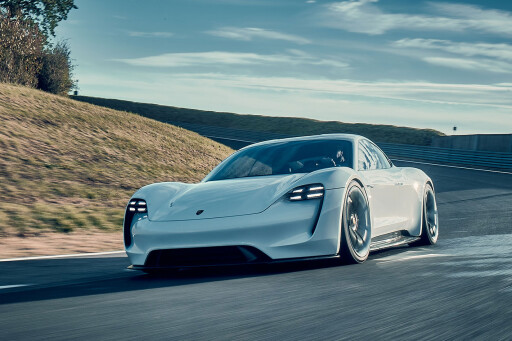 When the Mission E project – or J1 as it’s known internally within Porsche – goes into production in September 2019, it will somewhat resemble the design of the stunning concept unveiled at the 2015 Frankfurt Motor Show. Although conventional B-pillars will replace the eye-catching suicide doors, there will be enough headroom to wear a helmet and a more manageable width so as to not kerb a wheel in tight car parks. However, the basic silhouette, as you see here, is cast in stone. The unique four-eyed headlights, the trademark wraparound tail-lights, the striking proportions and the space-age interior are all set to remain.
When the Mission E project – or J1 as it’s known internally within Porsche – goes into production in September 2019, it will somewhat resemble the design of the stunning concept unveiled at the 2015 Frankfurt Motor Show. Although conventional B-pillars will replace the eye-catching suicide doors, there will be enough headroom to wear a helmet and a more manageable width so as to not kerb a wheel in tight car parks. However, the basic silhouette, as you see here, is cast in stone. The unique four-eyed headlights, the trademark wraparound tail-lights, the striking proportions and the space-age interior are all set to remain.
The Weissach research and development team are protecting their baby like a first born. To drive the Mission E, you actually need permission from the board of directors. You also need to be granted the goodwill of the specialised crew trained to deal with the bytes and bugs that tend to haunt such a one-off, high-voltage car. As we approach the object of desire on a Sunday morning in October, there is tension in the air, literally and figuratively speaking.
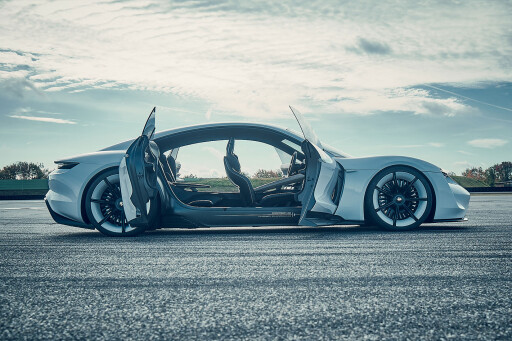 When only three other people have driven the Mission E without a passenger, you see how big a deal this is. I’m number four, the one person in the makeshift paddock who simply can’t stop smiling in anticipation. During the course of the past 24 months, the hand-built, metallic-white coupe has clocked less than 320km, most of which was conducted on the Portimao Circuit in Portugal.
When only three other people have driven the Mission E without a passenger, you see how big a deal this is. I’m number four, the one person in the makeshift paddock who simply can’t stop smiling in anticipation. During the course of the past 24 months, the hand-built, metallic-white coupe has clocked less than 320km, most of which was conducted on the Portimao Circuit in Portugal.
By definition and aesthetics, the GT2 RS is an entirely different kettle of fish. One look at the massive single-deck rear wing, the flared carbon-fibre sills and the protruding front splitter is all it takes to understand that this is definitely not a run-of-the-mill 911. It has presence in spades, but it’s functional, too. For example, that rear wing creates 340kg of downforce at maximum speed while, in Sport Plus, the two massive tailpipes emit a cacophony of sound and become virtual flame throwers. When viewed from behind at night the wide-body 911 looks like the devil’s very own chariot. All the louvres, ducts, splitters, aprons, skirts and air blades scattered around the muscular body manage to befriend the wind and placate the massive amount of heat emitted.
 It couldn’t be more different to the rather svelte, smoothed over Mission E. Sitting next to the extroverted GT2 RS, the understated four seater is shod with 245/35 ZR21s up front and enormous 285/30 ZR22s at the rear. While the RS loses an inch in diameter, the power-packed super coupe runs wider rear boots (325/30) to cope with the frenetic urge. And boy, does it need them – as we’ll soon discover.
It couldn’t be more different to the rather svelte, smoothed over Mission E. Sitting next to the extroverted GT2 RS, the understated four seater is shod with 245/35 ZR21s up front and enormous 285/30 ZR22s at the rear. While the RS loses an inch in diameter, the power-packed super coupe runs wider rear boots (325/30) to cope with the frenetic urge. And boy, does it need them – as we’ll soon discover.
On the inside, the Mission E has electric doors, windows and seats, along with a high-tech cockpit featuring five animated round instruments and a centre stack featuring a giant touchscreen (think Tesla). The classy, all-black centre stack – non-functional at the time of our test – is seamless and curved, and conveniently arranged for sound ergonomics. The ambience is clearly more iPad generation, but the designers did also apply classic luxury traits, such as supple leather with matching wood and metal accents.
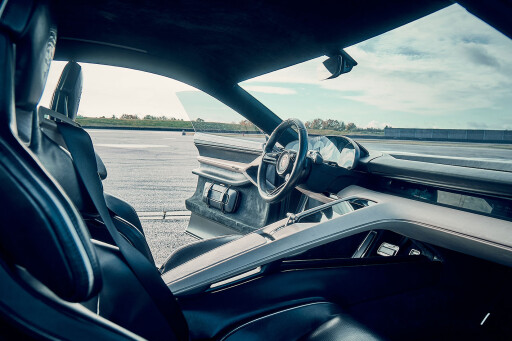 As you can imagine, the focus shift is immediately apparent in the GT2; it’s a driver-orientated environment. Our test car is devoid of radio and air-conditioning, the manual seat adjustment doesn’t extend to the backrest, there is no satnav and no Sport Chrono on the dashboard either. Yet, it just seems right for the RS. The thinly padded, single-piece bucket feels tailor-made in the way it holds your torso and supports your thighs. As a part of the Weissach Pack, the shift paddles for the PDK ’box are made of carbon fibre and the fully adjustable, single-function steering wheel is swathed in Alcantara. While the dashboard layout may be ageing, everything is exactly where it should be.
As you can imagine, the focus shift is immediately apparent in the GT2; it’s a driver-orientated environment. Our test car is devoid of radio and air-conditioning, the manual seat adjustment doesn’t extend to the backrest, there is no satnav and no Sport Chrono on the dashboard either. Yet, it just seems right for the RS. The thinly padded, single-piece bucket feels tailor-made in the way it holds your torso and supports your thighs. As a part of the Weissach Pack, the shift paddles for the PDK ’box are made of carbon fibre and the fully adjustable, single-function steering wheel is swathed in Alcantara. While the dashboard layout may be ageing, everything is exactly where it should be.
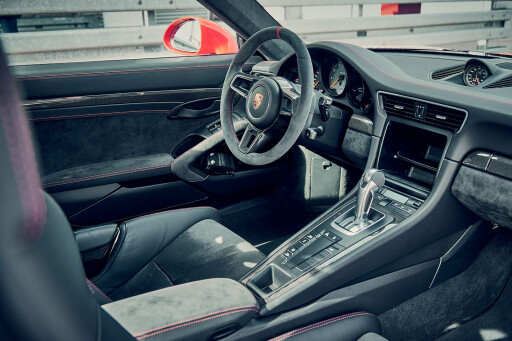 While the ultimate 911 replaces the rear seats with a roll cage made of titanium to save weight, its electric brethren includes comfy rear seats, given it is sans roll cage. Despite the low roofline, the seating position is surprisingly relaxed thanks to something called a ‘foot garage’. It is essentially Porsche-speak for a deep recess in the floorpan that splits the battery tray. Unlike the prototype driven here, the version signed off for production out of the Zuffenhausen plant will use an extension of the new MSB platform also used by the Cayenne III and Bentley Continental II.
While the ultimate 911 replaces the rear seats with a roll cage made of titanium to save weight, its electric brethren includes comfy rear seats, given it is sans roll cage. Despite the low roofline, the seating position is surprisingly relaxed thanks to something called a ‘foot garage’. It is essentially Porsche-speak for a deep recess in the floorpan that splits the battery tray. Unlike the prototype driven here, the version signed off for production out of the Zuffenhausen plant will use an extension of the new MSB platform also used by the Cayenne III and Bentley Continental II.
While the Mission E is undergoing final tests on its ECU by the men in Porsche coats, I take the chance to head out on track in the GT2 RS. The surface is still moist in some places and the marbles on both sides of the racing line shout caution. Taking it easy until the tyres get some temperature is definitely the right thing to do. It also gives me a chance to reacquaint myself with the Weissach track, which was built in 1972. Even the long variant is actually quite a short circuit with only thirteen corners, but because of the great variety of crests, climbs, descents and surface changes, the rollercoaster drive invariably gets the heart racing.
 The dashboard is pure 911, but with a twist, and when you start the engine a GT2 RS graphic shows up briefly on the screen next to the rev counter. The steering wheel rim is thick and there’s a yellow marker at the twelve o’clock mark designating the centre line. Two red stripes on the polished shifter gate have been used before on the 911R while there is a silver Weissach plaque on the glovebox door.
The dashboard is pure 911, but with a twist, and when you start the engine a GT2 RS graphic shows up briefly on the screen next to the rev counter. The steering wheel rim is thick and there’s a yellow marker at the twelve o’clock mark designating the centre line. Two red stripes on the polished shifter gate have been used before on the 911R while there is a silver Weissach plaque on the glovebox door.
I’m familiar with all the numbers as I’ve been in this car before. And yet, flooring the loud pedal for the first time in the most powerful 911 is breathtaking. Managing the mighty forward thrust is a challenge for all the senses. Adding an extra dash of drama, every move the GT2 RS makes has its own tone of voice. It has quirks and idiosyncrasies aplenty.
The next thing your ears register is the difference between cold and hot tyres, brakes and engine. Early on in the game the tyres drum, the brakes chafe and the engine conveys quite a hoarse soundtrack. But this car isn’t about mere progress. Still, testing the mid-range waters by cornering at 70 per cent and braking a bit too early is a good idea at first. Once comfortable, the GT2 RS begs to be whipped hard. After all, its reason for existence is to be a showcase of the great work completed by the engineers, putting its performance curve above many foes by being the pinnacle of the Porsche crop. However, it’s time to experience the future – one that is beckoning whether we like it or not.
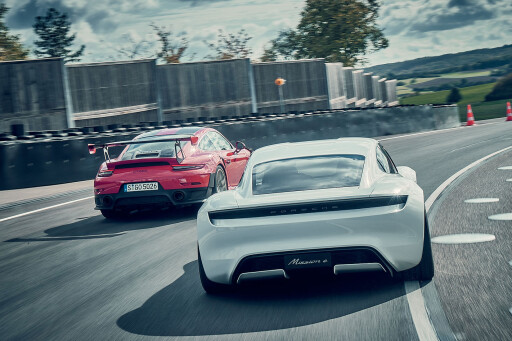 The Mission E concept shows a lot of promise. To deliver on it, Porsche has begun road-testing the first two Panamera-based prototypes. Although the chassis of the exhibition piece bears little resemblance to the finished product, all the essential functions are already working as they should. The steering is sharp, the suspension is confidence-inspiring, the tyres stick, the brakes are competent and the solitary e-motor kicks butt up to 120km/h. There is no doubt about it, Porsche’s first Battery Electric Vehicle (BEV) does not compromise on driving enjoyment.
The Mission E concept shows a lot of promise. To deliver on it, Porsche has begun road-testing the first two Panamera-based prototypes. Although the chassis of the exhibition piece bears little resemblance to the finished product, all the essential functions are already working as they should. The steering is sharp, the suspension is confidence-inspiring, the tyres stick, the brakes are competent and the solitary e-motor kicks butt up to 120km/h. There is no doubt about it, Porsche’s first Battery Electric Vehicle (BEV) does not compromise on driving enjoyment.
The plan from Germany is not only to make this a more committed and rewarding drive than the Tesla Model S, but to also warrant unconditional repeatability. And when you’ve got hypo cars in your portfolio such as the GT2 RS, the ‘future’ has to stack up to the present. However, to best the likes of Tesla, there needs to be some parameters the Mission E must meet in order for it to be deemed a success – both internally and in terms of sales. The batteries and motors must not heat excessively, the cell chemistry and single, highly complex cooling circuit must cope with recurrent, full-discharge cycles, and hour-long high-speed runs on the Autobahn must not eat the range in one fell swoop. Yet talk is cheap, a drive is in order to see what’s what.
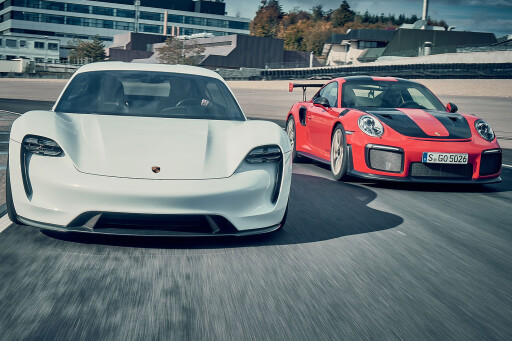 The nature of this miniature Nordschleife makes it easy to warm up all four Pirelli P Zero (ultra-high performance) tyres almost simultaneously. Early on, the front end of the Mission E likes to snap understeer when entering two of the tighter kinks and the ABS feels compelled to step in early. Given it takes a braver man than me to deactivate stability and traction controls (remember, this is currently a very rare car), the rear end contributes only the odd wriggle on corner exit before temperatures are up to scratch. With optimal pressures and temps achieved, the handling balance is sweet and, surprisingly, subtle. While the responses are quick, feedback is pragmatic rather than emphatic. When you’re in the zone, it doesn’t disappoint.
The nature of this miniature Nordschleife makes it easy to warm up all four Pirelli P Zero (ultra-high performance) tyres almost simultaneously. Early on, the front end of the Mission E likes to snap understeer when entering two of the tighter kinks and the ABS feels compelled to step in early. Given it takes a braver man than me to deactivate stability and traction controls (remember, this is currently a very rare car), the rear end contributes only the odd wriggle on corner exit before temperatures are up to scratch. With optimal pressures and temps achieved, the handling balance is sweet and, surprisingly, subtle. While the responses are quick, feedback is pragmatic rather than emphatic. When you’re in the zone, it doesn’t disappoint.
“If you like our sports cars, you will love the way Mission E drives,” promises project leader, Stefan Weckbach. “After all, this is the Porsche among the BEVs. It totally complies with our philosophy, fusing intuitive controls with a rear-bias torque split for emotional dynamics. Add to this the lower centre of gravity and available features like rear-wheel steering and active anti-roll bars, and it should not be difficult to imagine the result.”
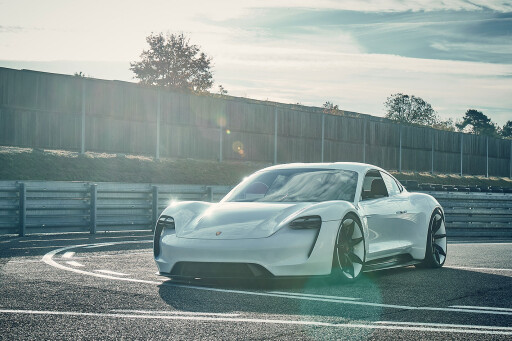 According to those in the know, Porsche is currently considering three different model grades to tie in with the rest of the range. The designation will start with the entry-level Carrera (300kW), before moving to Carrera S (400kW) and rounding out with a range-topping ‘Turbo’ (500kW). All-wheel drive will be standard fare initially, but later on in the piece we may also see a base-model, rear-wheel drive version. The front-wheel drive module delivers 160kW at 16,000rpm and a constant peak torque of 300Nm. At full boost, one can briefly claim as much as 440Nm. There are two different specifications in the works for the rear-drive unit. While the base motor is rated at 240kW/340Nm, the performance version is good for 320kW/550Nm, sources say. The two-speed transmission permits full-throttle upshifts and an electronically-controlled limited-slip rear diff will be an option.
According to those in the know, Porsche is currently considering three different model grades to tie in with the rest of the range. The designation will start with the entry-level Carrera (300kW), before moving to Carrera S (400kW) and rounding out with a range-topping ‘Turbo’ (500kW). All-wheel drive will be standard fare initially, but later on in the piece we may also see a base-model, rear-wheel drive version. The front-wheel drive module delivers 160kW at 16,000rpm and a constant peak torque of 300Nm. At full boost, one can briefly claim as much as 440Nm. There are two different specifications in the works for the rear-drive unit. While the base motor is rated at 240kW/340Nm, the performance version is good for 320kW/550Nm, sources say. The two-speed transmission permits full-throttle upshifts and an electronically-controlled limited-slip rear diff will be an option.
The GT2 RS boasts similar side-to-side traction along with rear-wheel steering, active dampers (PASM) and carbon-ceramic brakes. In fact, this is the first Porsche road-car engine equipped with water injection designed to cool off the heat exchangers. Whenever the intake air temperature exceeds 50 degrees and the driver buries the throttle to the firewall, the system (fed by a five-litre water tank) will kick in.
 In Sport, the venerable PDK ’box blips the throttle during downshifts, while switching the rotary dial to Sport Plus induces plenty of overrun theatre. The ‘clutch kick’ feature remains by pulling both paddles back simultaneously, briefly disconnecting the engine and transmission. It allows you to quell understeer or, conversely, destabilise the rear end so you can drift through a corner. The RS is also now more tied down than ever. The suspension is almost totally devoid of rubber mounts, buffers and bushings, which Porsche replaced with steel ball joints for enhanced poise and quicker responses.
In Sport, the venerable PDK ’box blips the throttle during downshifts, while switching the rotary dial to Sport Plus induces plenty of overrun theatre. The ‘clutch kick’ feature remains by pulling both paddles back simultaneously, briefly disconnecting the engine and transmission. It allows you to quell understeer or, conversely, destabilise the rear end so you can drift through a corner. The RS is also now more tied down than ever. The suspension is almost totally devoid of rubber mounts, buffers and bushings, which Porsche replaced with steel ball joints for enhanced poise and quicker responses.
However, what makes the GT2 RS so very, very special is the force-fed powerhouse that lurks beneath the carbon-fibre lid, which also accommodates two gaping air intakes to feed the turbos and a tall double-decker rear wing. The new 3.8-litre engine delivers a monstrous 515kW at 7000rpm, eclipsing the previous 3.6-litre unit by 59kW. At the same time, peak torque increases from 700 to 750Nm, available from 2500rpm. There’s a real sweet spot at 4500rpm, resulting in phenomenal mid-range punch. Despite this, what bends the mind most is the acceleration in fourth and fifth gears, giving the GT2 RS an uncanny ability to outpace just about anything on the road as all hell breaks loose in the final 1200rpm from 6000rpm to cut-out. To get a feel for how explosive this narrow rpm bracket really is, check out the onboard video which captures the recent record lap on the Nürburgring.
 Predictably, the Mission E will never be a V-max hero. Instead, it aspires to blend speed and effortlessness, comfort with charisma and minimum noise with maximum response. A real-life range of 440km has to also be met with an ability to recharge the batteries in about 10 minutes. To attain this seemingly far-fetched brief, the energy cells need to be pumped with 800V – or 400V at the very least. Unlike the 2019 Audi e-tron C-BEV, J1 relies on synchronous motors with permanent magnets for superior continuous performance and repeatability, as well as reducing weight and overall dimensions. Seemingly the only downside is the greater expense, which Porsche customers are typically willing to absorb.
Predictably, the Mission E will never be a V-max hero. Instead, it aspires to blend speed and effortlessness, comfort with charisma and minimum noise with maximum response. A real-life range of 440km has to also be met with an ability to recharge the batteries in about 10 minutes. To attain this seemingly far-fetched brief, the energy cells need to be pumped with 800V – or 400V at the very least. Unlike the 2019 Audi e-tron C-BEV, J1 relies on synchronous motors with permanent magnets for superior continuous performance and repeatability, as well as reducing weight and overall dimensions. Seemingly the only downside is the greater expense, which Porsche customers are typically willing to absorb.
Speaking of cost, it is worth noting that the Mission E is going to be priced between Cayenne and Panamera, and only slightly above the least expensive Tesla model S. While Porsche’s original goal was to build around 20,000 high-end BEVs per year, the unusually zealous marketing department has suggested that adding another 10,000 units to that tally is achievable.
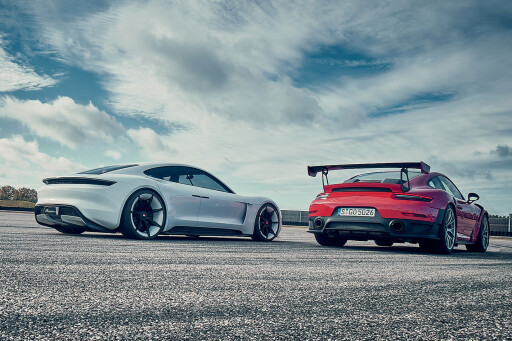 However, while the future might be set in battery packs and green dreams, the present still sees a set of keys available to me that many MOTOR readers – and many would-be owners who missed out – would kill to have in their hand. On the road, the GT2 RS fears nothing. Yes, something like the Bugatti Chiron is faster in a straight line, but not through tight corners. What about other contenders? The Lamborghini Huracan Performante comes close and is easier to drive, the Ferrari 812 Superfast carries a tad too much weight, the Corvette Z06 lacks traction while the Paganis and Koenigseggs of this world can do certain things better. However, on aggregate, the Porsche still wins.
However, while the future might be set in battery packs and green dreams, the present still sees a set of keys available to me that many MOTOR readers – and many would-be owners who missed out – would kill to have in their hand. On the road, the GT2 RS fears nothing. Yes, something like the Bugatti Chiron is faster in a straight line, but not through tight corners. What about other contenders? The Lamborghini Huracan Performante comes close and is easier to drive, the Ferrari 812 Superfast carries a tad too much weight, the Corvette Z06 lacks traction while the Paganis and Koenigseggs of this world can do certain things better. However, on aggregate, the Porsche still wins.
If we’re being really honest, for most of us the 368kW GT3 would be more than enough, but, of course, there’s always the upcoming 991.2 GT3 RS, which promises to be more track focussed than the pricey 515kW all-rounder. Ultimately, the GT2 RS makes you recalibrate your inner speedometer. A judgement adjustment needs to be made regarding relative distances, braking markers and the limit of adhesion. The GT2 RS really does up the ante that much in all the aforementioned areas. On a good day in dry weather with little traffic you’ll be left in no doubt that this is the real McCoy. It is, currently, the 911.
 As the day closes, I’m braking later, moving closer to the apex and getting back on the throttle earlier and earlier in the GT2 RS. Although, at this point, speed is being picked up in smaller doses as the tyres and brakes work harder and my margin for error narrows with confidence. The secret to super-fast progress is to let the masses of torque do its job, unwind lock early and to keep revs in the higher reaches of the rev range. Putting faith in the stability/traction systems to sort out fishtailing on corner exit as the second turbo kicks in also reaps rewards.
As the day closes, I’m braking later, moving closer to the apex and getting back on the throttle earlier and earlier in the GT2 RS. Although, at this point, speed is being picked up in smaller doses as the tyres and brakes work harder and my margin for error narrows with confidence. The secret to super-fast progress is to let the masses of torque do its job, unwind lock early and to keep revs in the higher reaches of the rev range. Putting faith in the stability/traction systems to sort out fishtailing on corner exit as the second turbo kicks in also reaps rewards.
It’s essential to keep a firm grip on the wheel because every ridge, painted kerb and expansion joint will want to make the GT2 RS rip its rear wing off. The biggest dare on this diminutive track is to keep the right hoof firmly planted from the exit of the last bend to the entry of the first right hander. Wide eyed, we briefly saw 270km/h before stomping on the anchors – hard. It’s enthralling and all a bit too much to take in for just one moment in time.
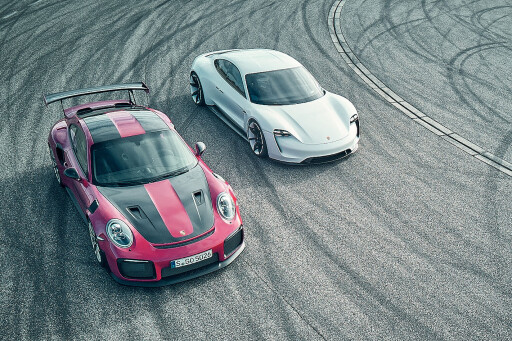 There may never be another day like this again. However, what we can tell you is that there is much more to come from the Weissach think tank – be it petrol-powered or not. High-voltage dreams like the final production version of the Mission E, a proposed fully electric 928-style two-door coupe derived from the same DNA and the all-electric Macan replacement are all in the works. However, we can’t forget the hyped GT3 RS and Speedster as the last 991 derivatives before the all-new 911, nee 992, arrives late 2018. And, naturally, it will in time be complete with a hybrid power pack when its ready for market. There’s no doubt about it, the future of Porsche is now.
There may never be another day like this again. However, what we can tell you is that there is much more to come from the Weissach think tank – be it petrol-powered or not. High-voltage dreams like the final production version of the Mission E, a proposed fully electric 928-style two-door coupe derived from the same DNA and the all-electric Macan replacement are all in the works. However, we can’t forget the hyped GT3 RS and Speedster as the last 991 derivatives before the all-new 911, nee 992, arrives late 2018. And, naturally, it will in time be complete with a hybrid power pack when its ready for market. There’s no doubt about it, the future of Porsche is now.
The Numbers – The Future and the Present
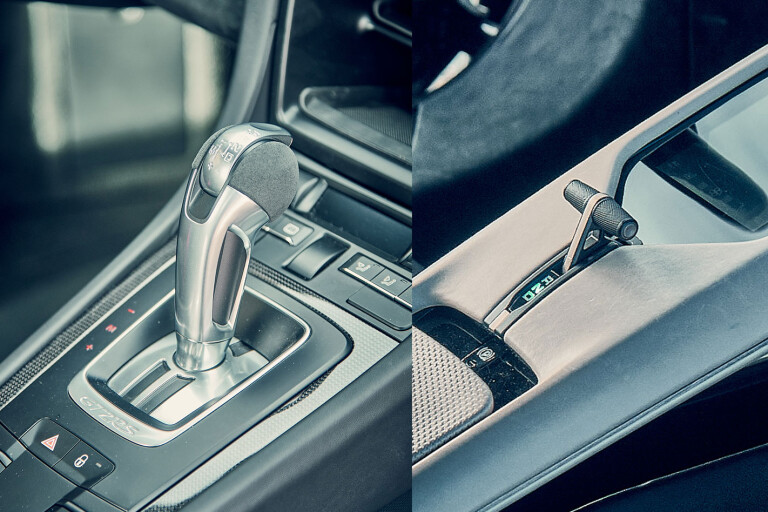
| PORSCHE 911 GT2 RS | PORSCHE MISSION E | |
| BODY | 2-door, 2-seat coupe | 4-door, 4-seat coupe |
| DRIVE | rear-wheel | all-wheel |
| ENGINE | 3800cc flat-6, DOHC, 24v twin-turbo | Permanent magnet synchronous |
| BORE/STROKE | 102.0 x 77.5mm | N/A |
| COMPRESSION | 9.0:1 | N/A |
| POWER | 515kW @ 7000rpm | 300-500kW |
| TORQUE | 750Nm @ 2500-4500rpm | 850Nm |
| POWER/WEIGHT | 350kW/tonne | 136-227kW/tonne |
| TRANSMISSION | 7-speed dual-clutch | 2-speed |
| WEIGHT | 1470kg | 2200kg |
| SUSPENSION (F) | double A-arms, adaptive dampers, anti-roll bar | double A-arms, adaptive dampers, active anti-roll bar |
| SUSPENSION (R) | multi-links, adaptive dampers, anti-roll bar | multi-links, adaptive dampers, active anti-roll bar |
| L/W/H | 4549/1880/1297mm | 4850/1990/1300mm |
| WHEELBASE | 2453mm | N/A |
| TRACKS | 1588/1557mm (f/r) | N/A |
| STEERING | electrically assisted rack-and-pinion, four-wheel steer | electrically assisted rack-and-pinion, four-wheel steer |
| BRAKES (F) | 410mm carbon-ceramic discs, 6-piston calipers | N/A |
| BRAKES (R) | 390mm carbon-ceramic discs, 4-piston calipers | N/A |
| WHEELS | 20.0 x 9.5-inch; 21.0 x 12.5-inch (f/r) | 21.0 x 8.5-inch (f); 22.0 x 10.0-inch (r) |
| TYRE SIZES | 265/35 ZR20 (f); 325/30 ZR21 (r) | 245/35 ZR21 (f); 285/30 ZR22 (r) |
| TYRE | Pirelli P Zero | Pirelli P Zero |
| PRICE AS TESTED | $645,400 | $200-400,000 (est.) |
| LIKES | Torque-laden grunt; razor-sharp handling; ’Ring-smashing pace | An unwavering commitment to driver enjoyment; charging time |
| DISLIKES | Allocations are all accounted for; It’s not exactly cheap – if you can get one | No noise; we’ll have to see if Porsche can deliver electric-only thrills |
| RATING | 5 out of 5 stars | TBC |

COMMENTS